
DNA ERA: Case study
DNA ERA used Forvio to boost its marketing strategy and revenue.
About DNA Era
Slovakia-based DNA ERA is a biotech company that specializes in providing its customers with information about their predispositions related to health, nutrition, and sports performance through DNA analysis.
The company entered the market in 2021 with the ambition to offer genetic analysis to anyone who wishes to take charge of their health.
With increasing investments, DNA ERA is expanding into neighbouring markets such as the Czech Republic and Poland, with plans for further expansion in the future, aiming to contribute to the emergence of personalised medicine and healthcare.
Objectives
To acquire new customers, DNA ERA runs digital ads on all major platforms as Meta Ads and Google Ads. Like Other retailers, DNA ERA sees excellent results from these campaigns during peak shopping events like Black Friday, but the company struggled to optimize marketing spend the rest of the year. Contributing to this challenge was a prolonged consideration period, sometimes spanning 1-3 months, for consumers who buy a DNA ERA test kit, as well as a general low awareness of genetic predisposition tests among the public-making performance marketing channels less effective for the company.
To better understand the realistic performance the company could expect from each channel, given those channels were primarily converting consumers who were already at the point of making a decision, DNA ERA needed to move away from traditional last-touch attribution. Additionally, the company wanted to optimize advertising for periods outside of peak shopping events.
- Enhance year-round marketing efficiency by analyzing channel performance, especially during non-peak periods.
- Address prolonged consideration period and low awareness to enhance performance marketing effectiveness for DNA ERA test kits.
- To move away from traditional last-touch attribution and adopt a more comprehensive approach to evaluating channel performance, with the aim of acquiring new customers more efficiently and effectively.
Solution
1. Data collection & Channels split
The DNA ERA models were prepared using four different data sources. Data were loaded via built-in integrations with Meta Ads, Google Ads, Google Search Console, and Google Sheets containing conversion and sales data.
Channel split used for Google Ads was based on channel type dimension, which resulted in three categories: SEARCH, DISPLAY & VIDEO, PMAX.
Meta platform was categorized based on campaign names into Acquisition, Remarketing, and Other campaigns.
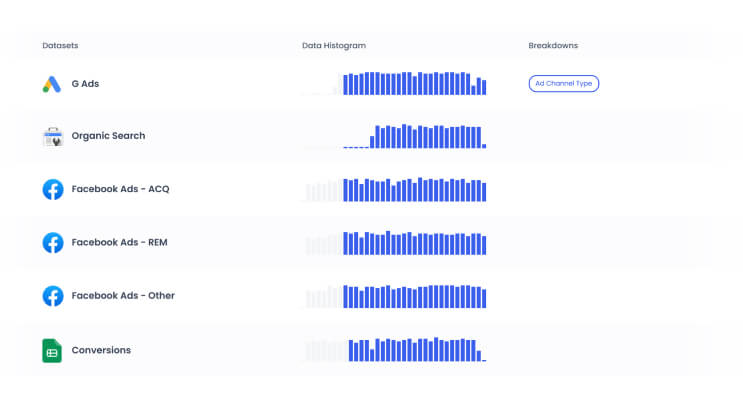
2. Model strategy
DNA ERA is currently available in three countries: Slovakia, Czechia, and Poland. Two models were created for each country. It was critical to define the most effective target variables and core KPIs for all of these models.
DNA ERA operates across three funnel stages:
Lead - where individuals share contact information and engage with demo applications
High Score Lead - determined internally
Customer - marked by a purchase event
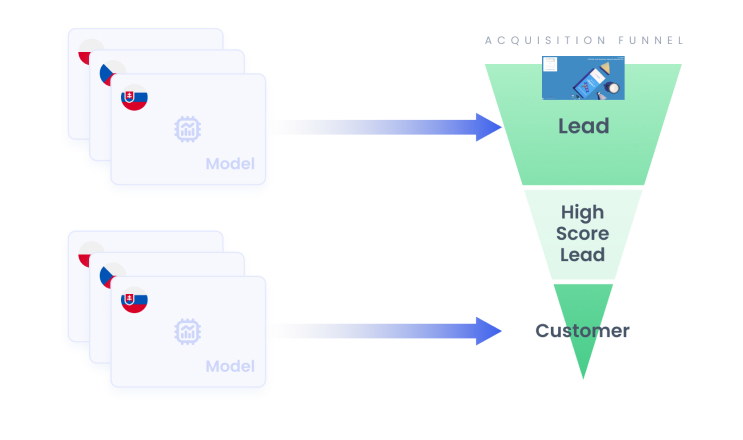
3. Events and Holidays
Standard national holidays were added into each model, along with specific promotion periods for each country. This functionality is included in the modeling process by adding contextual regressors that, when aggregated, explain the target curve.
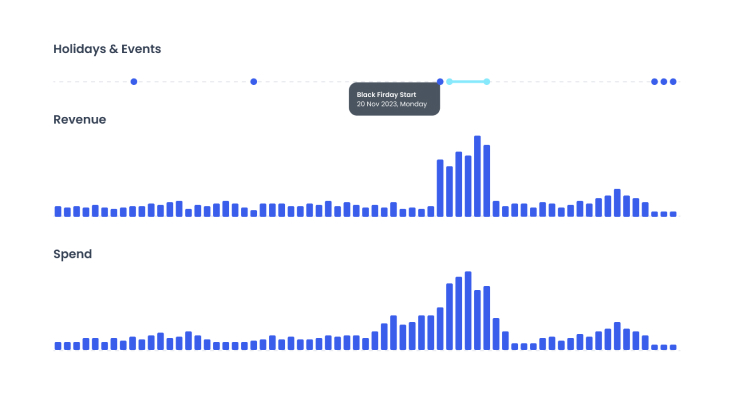
4. Model outcomes
Revenue-based models were prioritized over lead-based models due to their enhanced robustness. To bolster model resilience, a two-week observation period was established, enabling the evaluation of model performance on new data. Subsequently, more aggressive media mix scenarios involving substantial spending variances were created in the scenario planner. The primary goal was to grasp and calculate channel-level incrementality through saturation curves and meticulous examination of varying ROAS values before and after the model adjustments.
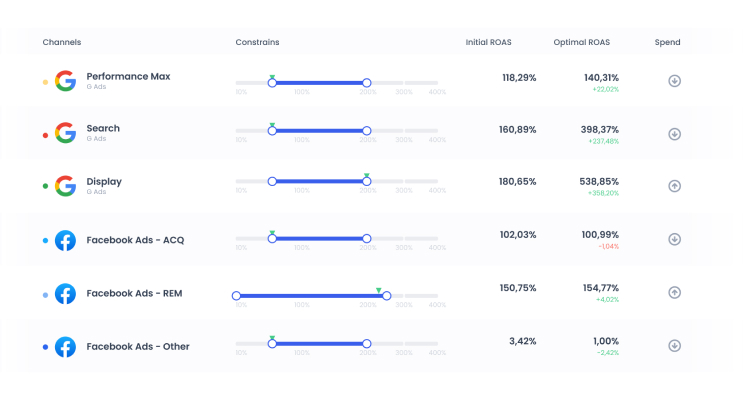
5. Validation & Iterations
The validation process utilized the overall marketing efficiency ratio and conducted impact evaluations and model rebuilds every two weeks. Several two-week cycles were run until a winning media mix was identified. A comprehensive conversion lift study is still in the planning stages.
The final validation was achieved by examining the overall sales changes along with the marketing efficiency ratio, which is calculated as total marketing spend relative to revenue.
The Forvio app offers various views, but the running 7-day ratio value is generally the best indicator of overall bottom-line performance change.
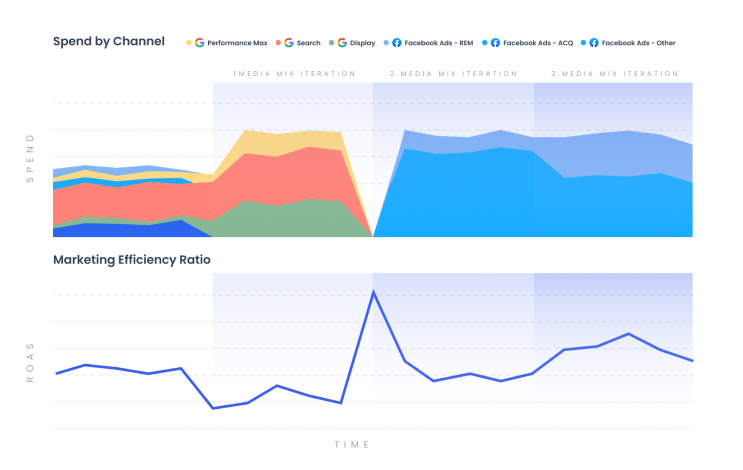
Timeframe
Week 1
Keek-Off Meeting
Week 2
Data Collection, 1st Model
Week 3
Goals Setting
Week 4 - 5
Validation
Week 6 - 7
1st Media Mix Iteration
Week 8 - 9
2nd Media Mix Iteration
Week 10 - 11
3rd Media Mix Iteration
Results
By transitioning from a monthly budget allocation based on multi-touch attribution to a more fluid, MMM-based approach for evaluating and optimizing advertising, DNA ERA achieved a 20% increase in revenue. This notable improvement was partly due to better optimization of ads outside peak shopping events, allowing for a balance between new customer acquisition and remarketing objectives.
Forvio’s MMM analysis also confirmed DNA ERA’s hypothesis that its customers take longer than average to arrive at a purchase decision. As a result, DNA ERA shifted budget toward Meta remarketing campaigns while reducing investment in search, ultimately increasing the overall ROAS of paid marketing campaigns by 25%.
| 20% | Increased revenue by 20% in 3 months, with space for more potential growth. |
|---|---|
| 25% | Achieved a 25% increase in ROAS |

“As a technology startup operating on a tight marketing budget, DNA ERA faces challenges in driving awareness of our products. Additionally, our lengthy customer purchase process had limited our remarketing opportunities, making it difficult to optimize performance marketing in the short-term. Transitioning to a more frequent budgeting and optimization process using marketing mix modeling from Forvio wasn’t straightworward-but it has driven continuous improvements in return on investment and growth.”
